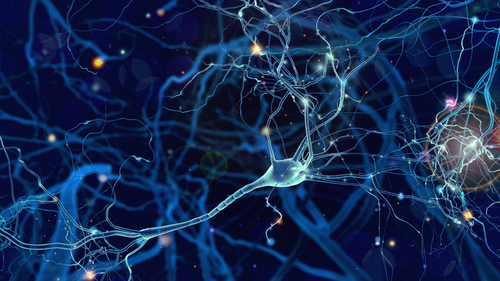Excess Activity in Striatum May Underlie Parkinson’s Symptoms, Mouse Study Suggests

The loss of dopamine causes neurons in the striatum — a brain region involved in voluntary movement control — to change their activity, explaining some of Parkinson’s hallmark symptoms.
Instead of firing in sequence, some of these neurons are overactive and fire simultaneously, making the mice have a repetitive rotation behavior — a common feature of rodent models of Parkinson’s disease.
The research, “Synchronized activation of striatal direct and indirect pathways underlies the behavior in unilateral dopamine-depleted mice,” was published in the European Journal of Neuroscience.
The loss of dopamine-producing neurons in the midbrain of a Parkinson’s disease rodent model causes a decrease in body movement, deviated posture, and spontaneous circling behavior toward the lesion side.
It was also reported that reducing the number of dopamine-producing neurons within the striatum increases the activity of the remaining striatal neurons on the lesion side.
“When you take dopamine away, the cells reorganize, and that reorganization leads to most of the symptoms of Parkinson’s,” Gordon Arbuthnott, PhD, senior author of the study and principal investigator of Japan’s Okinawa Institute of Science and Technology Graduate University (OIST) Brain Mechanism for Behaviour Unit, said in a news release.
Striatal projection neurons usually don’t fire simultaneously, but research shows that these cells start overworking themselves, and doing so rhythmically, in the absence of dopamine.
Dopamine D1 and D2 receptors are the most abundant dopaminergic receptors in the striatum. Although there’s still no consensus about the function of D1 and D2 neurons, D1 cells are thought to help initiate movement while D2 neurons suppress it. In a healthy scenario, these nerve cells work together to adapt a person’s response to a given motor situation.
Blocking dopamine receptors D1 and D2 in striatal projection neurons has been shown to provoke akinesia (loss of the ability to move muscles voluntarily) in a way that mimics what happens when there is dopaminergic neuronal loss, but evidence suggests the previously mentioned hyperactive rhythmic phenomenon is greatly influenced by D2 neurons.
OIST investigators set out to further understand the role of dopamine in striatal projection neurons. To do so, they used a technique called calcium imaging to evaluate the neurons’ activity.
In neurons, calcium signals regulate processes including cell death, brain chemical messengers’ release, and neuronal activation. By using fluorescent dyes that bind to calcium molecules, scientists can directly measure the dynamic calcium flux within neurons.
Sixty-four transgenic mice had an enhanced green fluorescent protein (eGFP) attached to D1 and D2 receptors within dopaminergic neurons. This protein allowed researchers to observe, under a microscope, the location of such molecular receptors.
Then, researchers injected 6‐hydroxydopamine (6‐OHDA), a neurotoxin that causes the death of dopamine-producing neurons, into the left substantia nigra pars compacta — a midbrain area important for muscle control.
A dopamine agonist called apomorphine is commonly used to trigger rotational behavior (circling) to assess whether the 6-OHDA-induced neuronal death is successful. Of note, the more an animal moves in circles, the greater the 6-OHDA lesion is.
A week after the injection, mice were administered apomorphine and turning behavior was assessed for 5 minutes. Only the animals that turned over 5 times per minute were considered to have adequate dopamine depletion and were included in subsequent testing.
After that, scientists generated adeno-associated viruses (AAV) carrying a light-sensitive protein, which enables light-induced neuronal activation, and a calcium indicator dye. The AAV combination was injected into the animals’ striatum.
In control animals, D1 and D2 striatal projection neurons had sparse spontaneous activity. However, the loss of dopamine in 6-OHDA-treated animals triggered a significant and synchronous increase in the number of these nerve cells, in comparison to the control sample.
Researchers found that the pattern of light stimulation caused different behaviors in animals.
“With continuous light (15 seconds), animals displayed turning behavior similar to 6‐OHDA- treated animals, that is, toward the side stimulated. With stimulation in patterned pulses (14 Hz) animals displayed turning behavior opposite to the stimulated side,” they said.
“The fact that, when I changed the stimulation, the animal turned to the opposite side — that was shocking,” said Omar Jaidar, PhD, first author of the study and a postdoctoral scholar in the Arbuthnott Unit at the time of the research.
Researchers also noted that both D1 and D2 neurons had three sets that generated sequential activity states. The state that had the largest number of active striatal projection neurons dominated the other two. Further analysis revealed that such cells projected into other brain regions.
“You need a certain sequence of muscles to contract to execute any movement, and it’s the same with [striatal] neurons,” Jaidar said.
Contrary to previous research, this study shows that D1 and D2 striatal projection neurons equally contribute to the unusual neuronal activity observed in Parkinson’s disease models. In conclusion, scientists should combine efforts to determine brain network activity so that disease-specific treatments can be developed based on network functional abnormalities.






